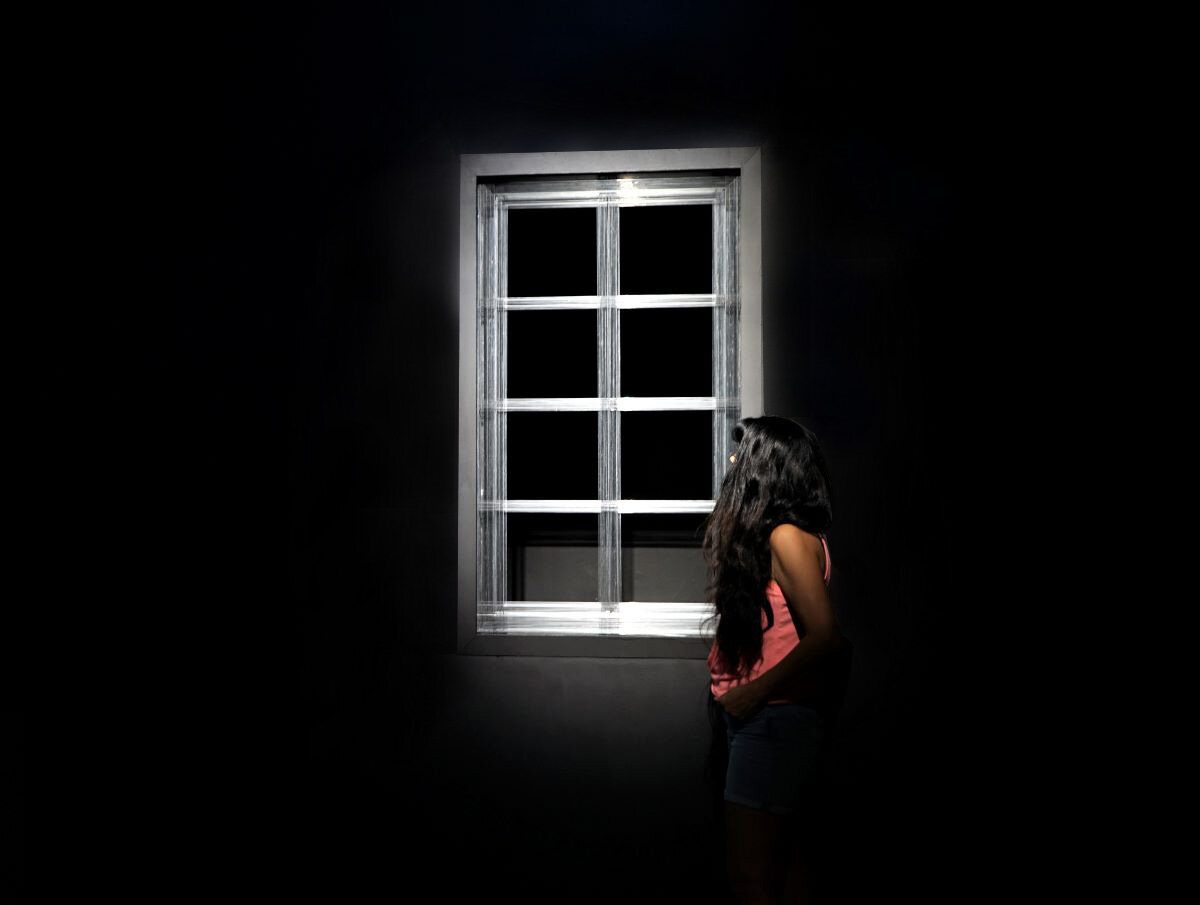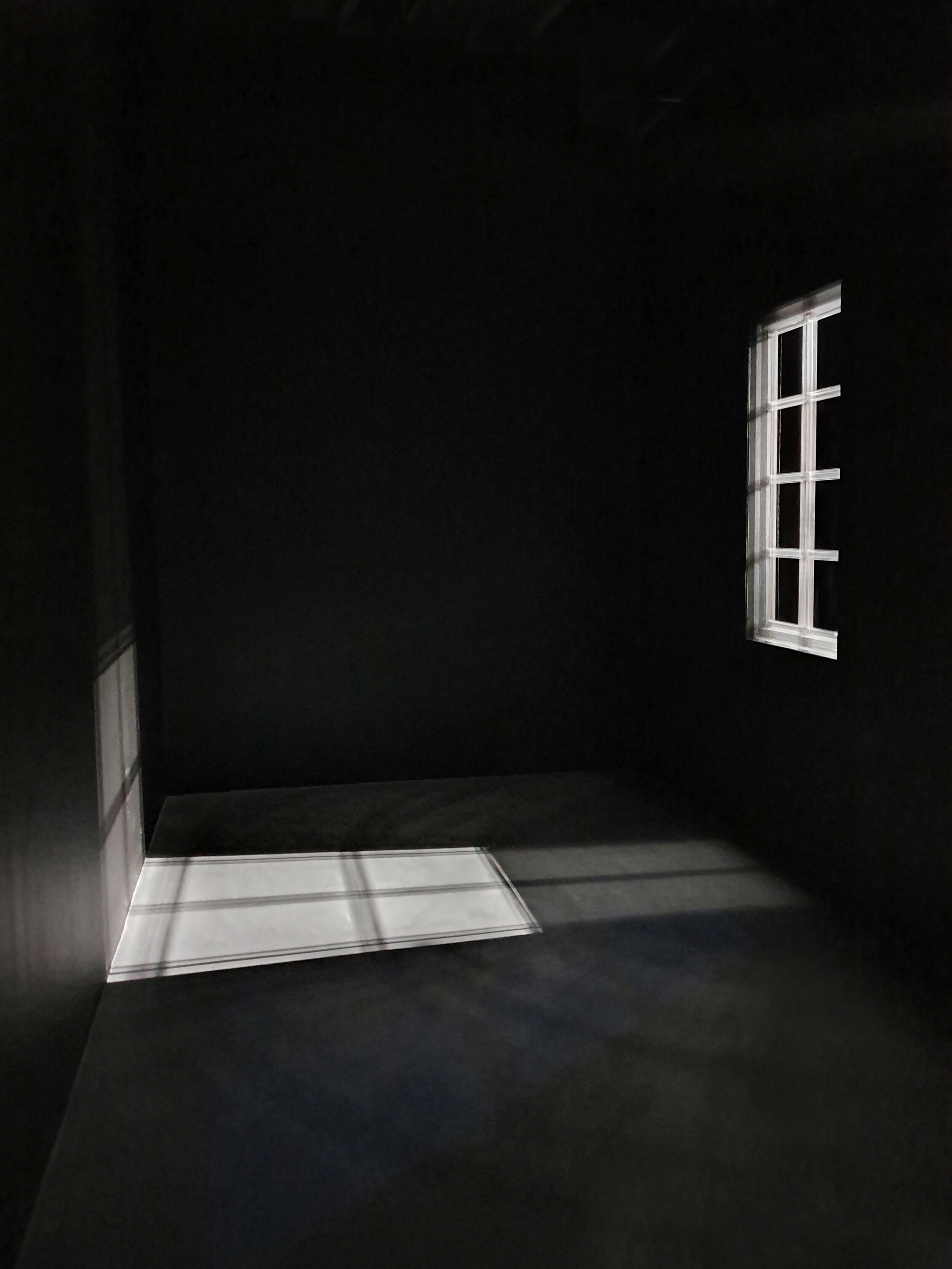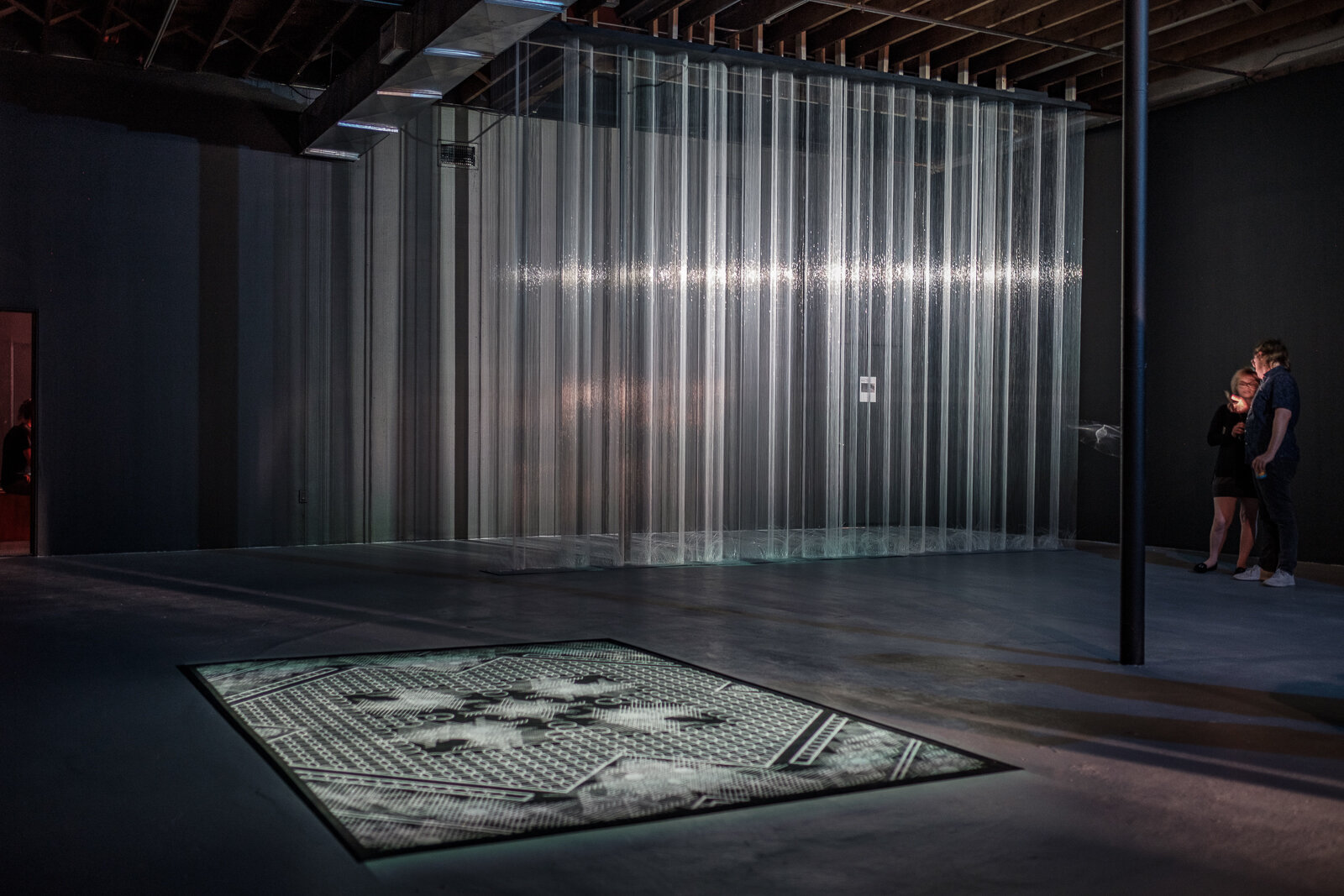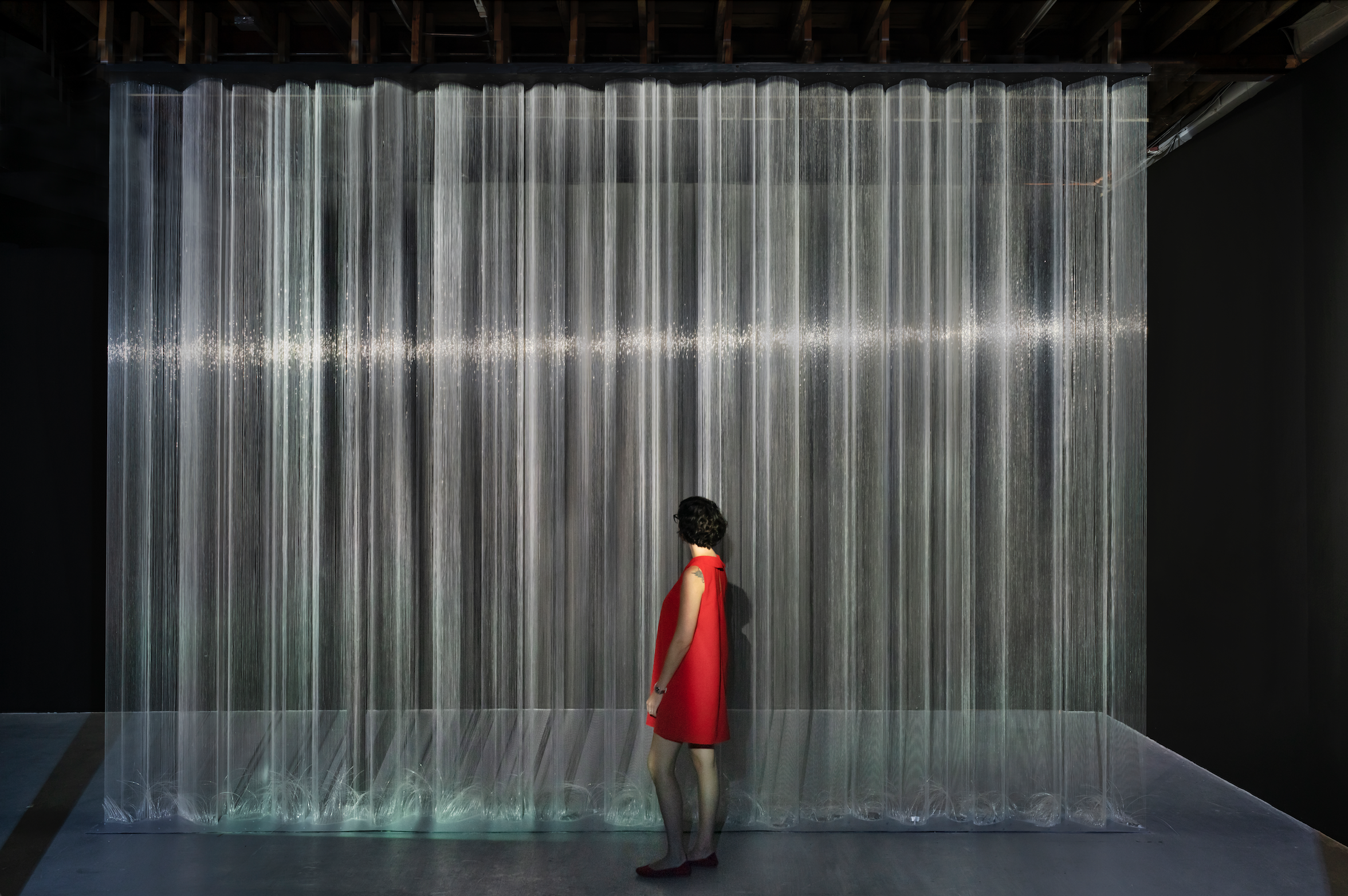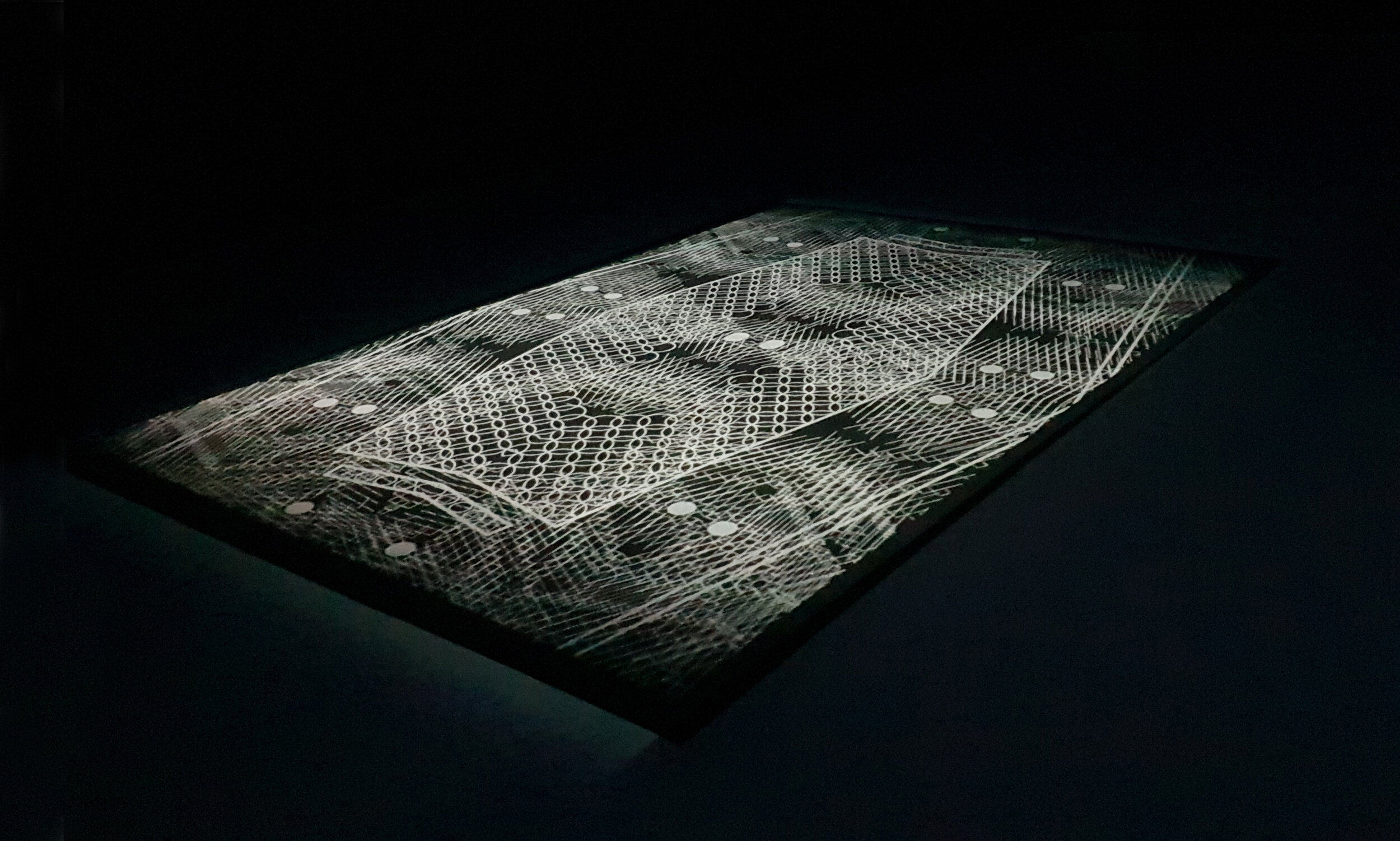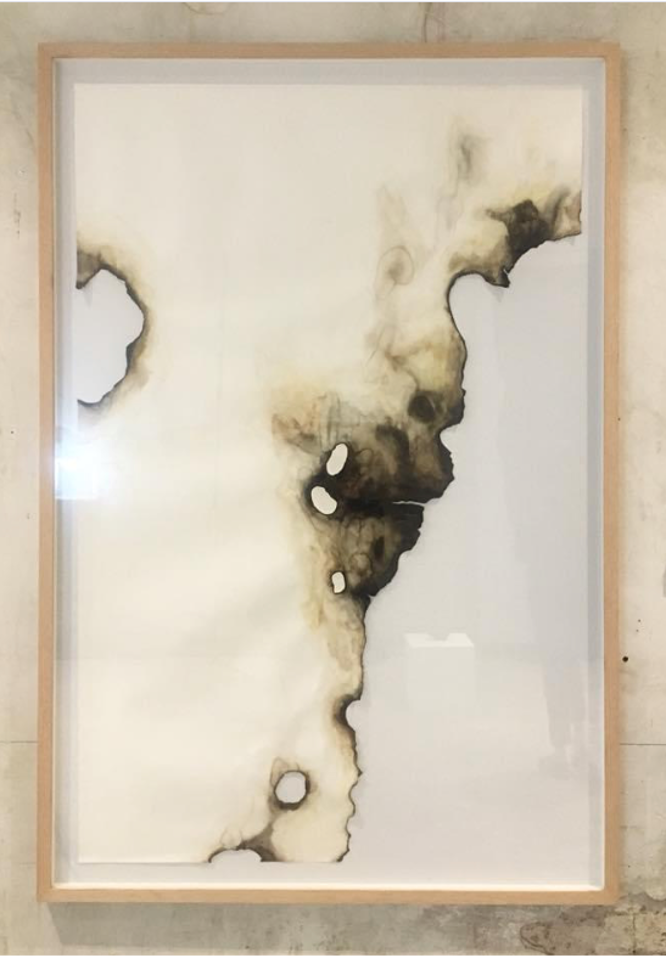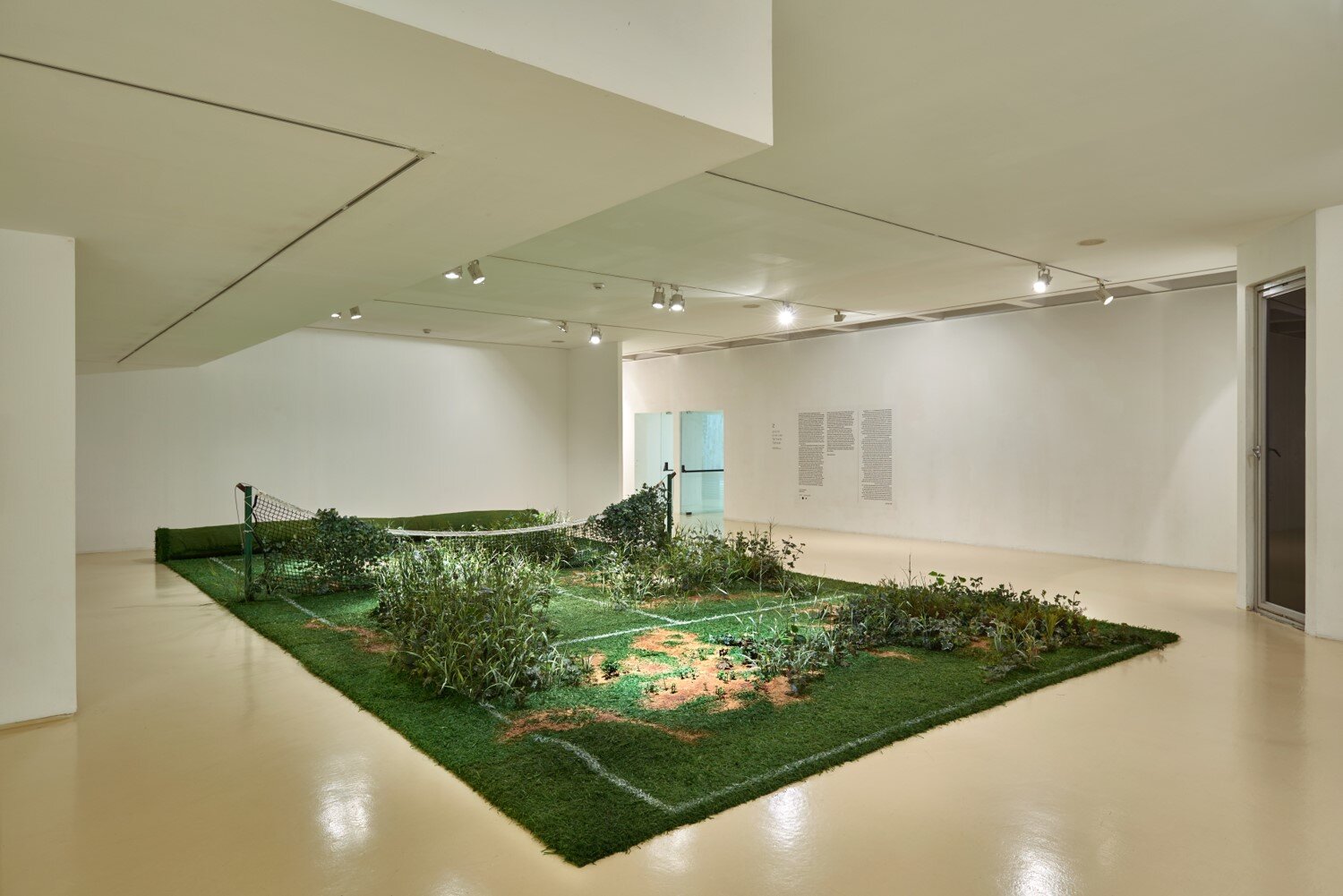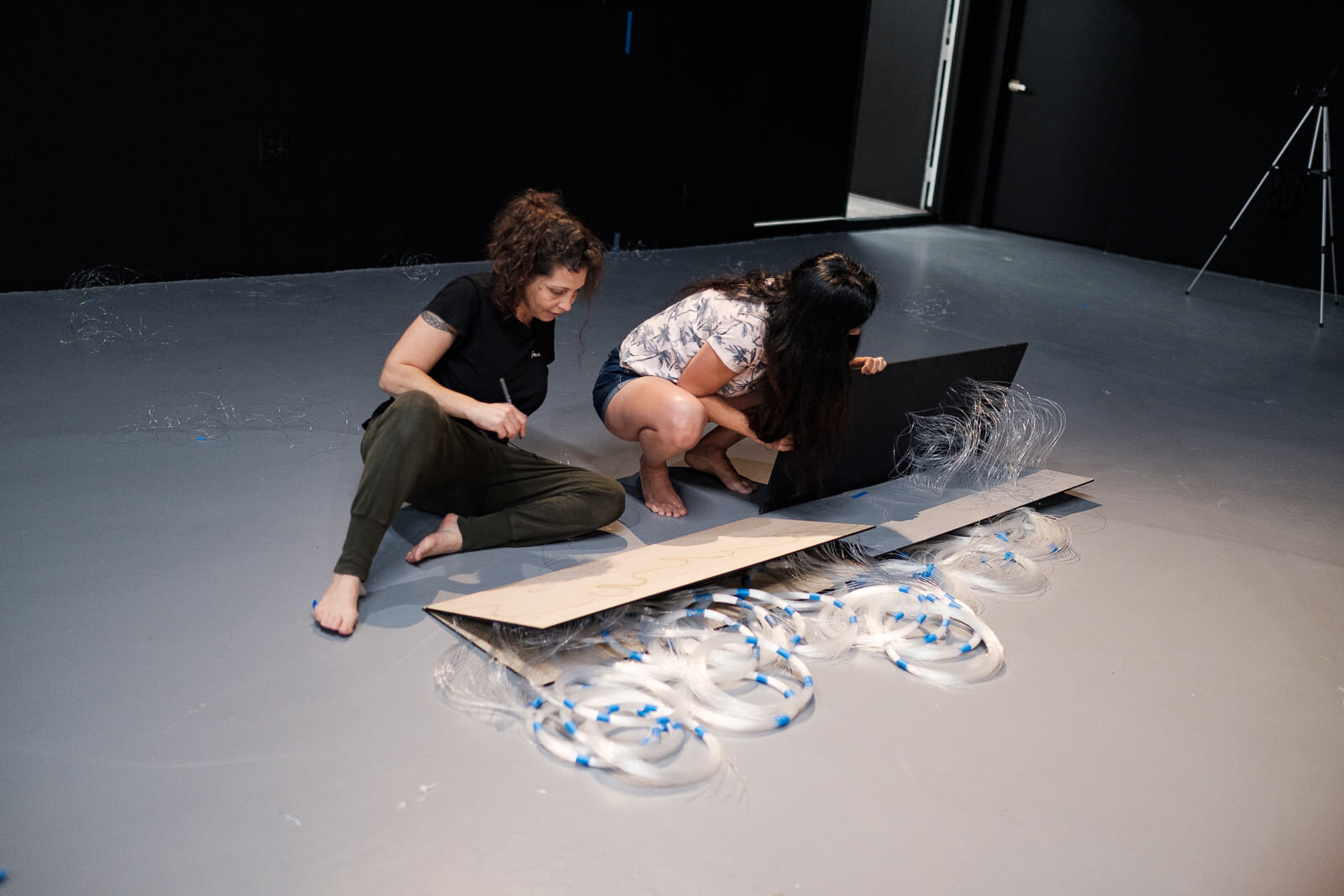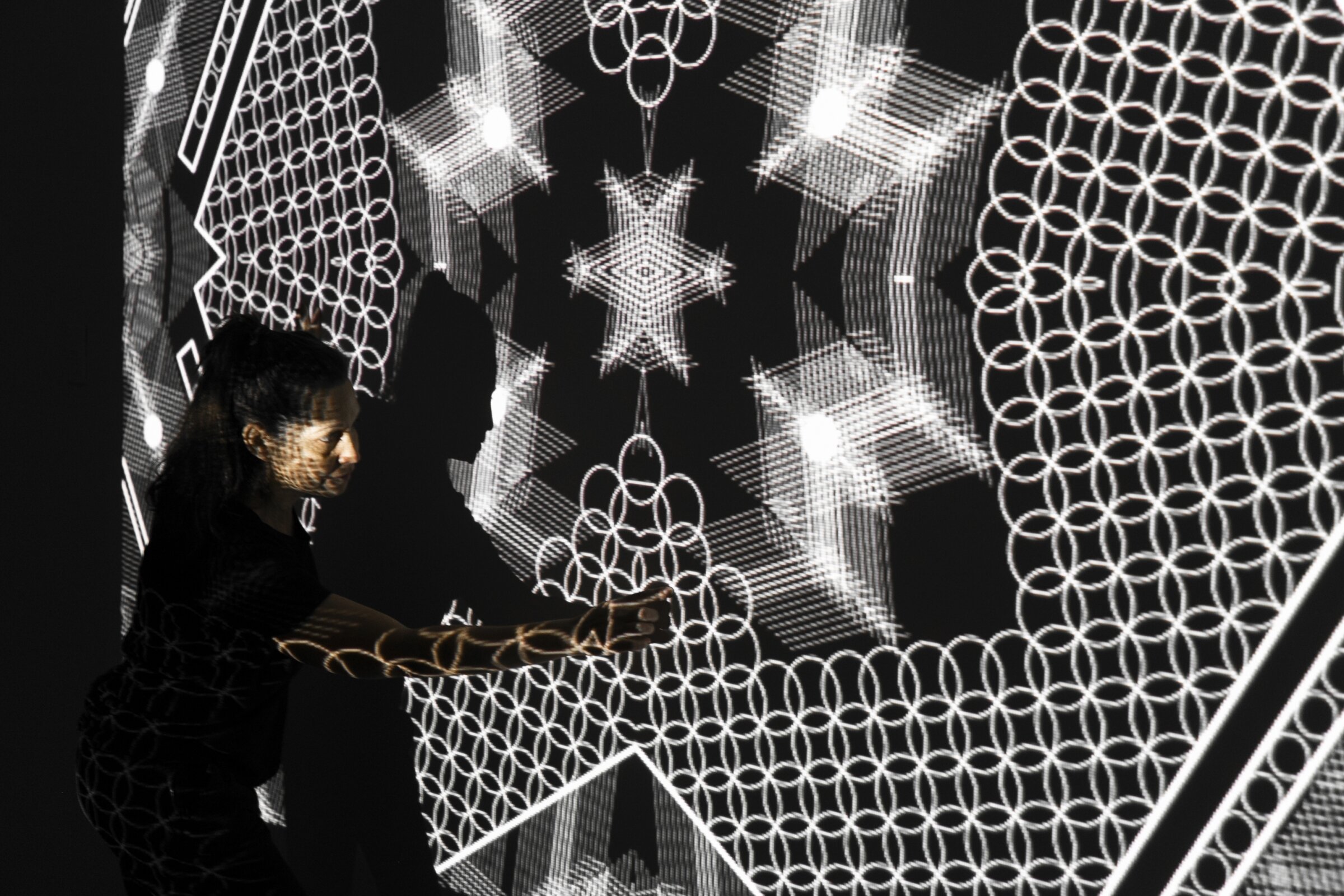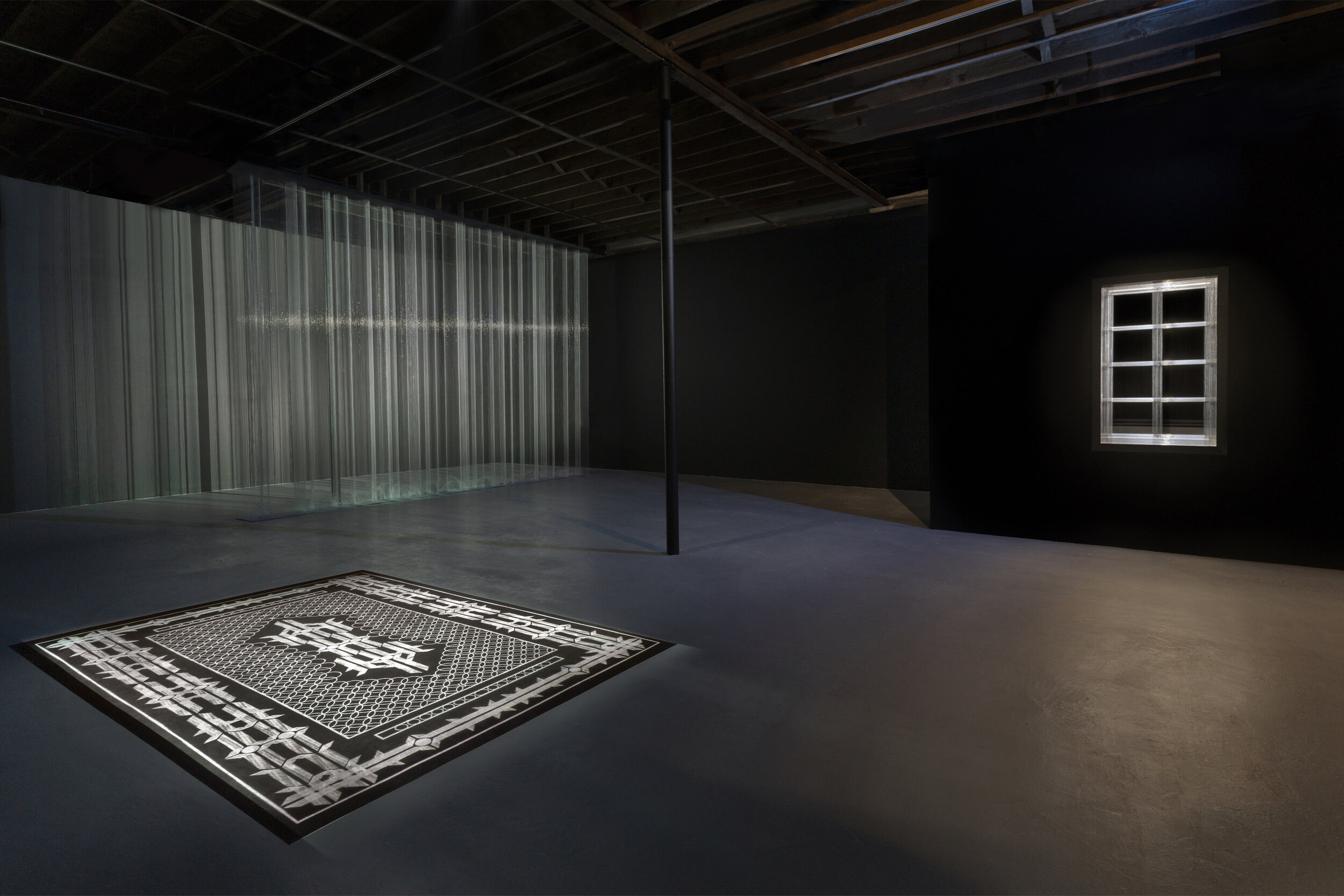Magical Threads and Meditative Carpet in the Frequency of Zen Poems | By Tami Katz-Freiman
Homeline, the first collaboration between Tal Amitai-Lavi and Tal Frank, is a site-specific project composed of three domestic elements created out of unexpectedly weightless materials including, light, projection and delicately-installed, ultra-thin nylon strings, presented in a completely dark space.
Entering the space, the first element one encounters is a window, Homage to Marcel (2021), created by Tal Amitai-Lavi and inspired by Marcel Duchamp’s Fresh Widow. Housed within drywall in a finished, two-sided wall built for the show, Homage to Marcel physically divides the space in a way that undermines solid notions of interior and exterior, visible and invisible. Standing in front of the window the viewer may see another standing on the opposite side, seemingly mirroring their reflection. The optical illusion is deceiving, and it is unclear whether the space beyond the window is real or imaginary. The play of light and materials makes the window look like it is flickering or dissolving, causing an ambiguous sense of depth and precarious feeling of staring into another dimension.
Amitai-Lavi also created the second element, Untitled (2021), a large-scale curtain that spans the length of the rear wall of the space and seems to slightly move, blown by an imperceptible wind of unknown origins. It is made through an obsessive, meticulous process of stretching thousands of thirteen-foot long, thin transparent nylon strings. The curtain shimmers in the dark under undulating light beams coming from a video projector which emphasizes its fragility while its gossamer qualities undermine its functionality. The optical experience of the elusive and hypnotic motion of the screen is enchanting. Rooted in the performing arts, mythology and art history, the origins of the curtain can be associated with the “theatrical screen” and the act of painting (1).
The third element, which was created by Tal Frank, Floor Plan (2021), is a projection on the floor of an animated carpet featuring a kaleidoscope-like labyrinth pattern based on architectural elements from Locust Project’s floor plan. Each subtly moving shape in the video animation corresponds to a wall, doorway, or column in the actual space creating geometric carpet patterns reminiscent of those in a Turkish rug. Frank utilized 3D software to create the illusion of a realistic textile material and morphing movements, similar to fractal forms in nature, creating a “digital sculpture,” composed of ornamental geometric shapes modified and recreated from 3,420 unique frames.
These three elusive semi-objects generate a succinct, close-knit architectural-sculptural setting in an encompassing environment of black and white. The installation as a whole is immersive and contemplative, playing with reflections, inversions, illusions, and space disruptions creating an illusionistic, dreamlike environment. The airy, transparent, ghostly character of the strings, along with the light beams and projections, constitute the weightless “volume” of the forms and together orchestrate the magic. The rhythmic flickers of light that vibrate as one wanders the space, convey an air of mysticism, like timeless rays of light found in mysterious spaces. By entering a world where foundations appear to be dissolving and life-sized architectural structures have lost their functionality and physicality, the viewers are challenged to rely on their senses while questioning their perception.
Magic is a key word in both Amitai-Lavi’s and Frank’s work. In both cases, the core of their work is anchored around the wonder of metamorphosis—both in material and space. For many years, Amitai-Lavi has worked with austere, fragile and unusual materials, such as sewing threads, nylon strings, kinetic sand, baking soda, and lighting. Her first work (in collaboration with Haimi Fenichel) with light beams and nylon strings was a bookshelf, Untitled (2006), which was also displayed in a dark space as part of Fatamorgana, a show I curated at the Haifa Museum of Art in Israel. It functioned there as a marker, as a trace of an object or a drawing in space. The books lost their physical presence and appeared like ethereal x-rays that consist only of a cultural memory and a spiritual charge. In her recent body of work she was actually sculpting with light beams. Her solo show Light Construction at Chelouche Gallery of Contemporary Art in Tel Aviv (2014), featured a combination of sewn threads unfolding a story about a destroyed house damaged by a storm with a life-size door made of nylon strings leading nowhere and a colonnade supporting nothing.
Over the years, she further refined and restrained her voice, using an increasingly frugal language, while exploring the same subject matter since the beginning of her career: HOME in its most profound meanings, especially its inherent reference to “stability” or promise for “shelter and safety.” The minimalist approach via her ongoing reductive process, distances her from narrative and brings her closer to the hardware, to the architectural element itself, to the threshold and to the windowsill, to the supportive walls and columns and thus—to the poetics behind the discourse of HOME and its vulnerability.
Magic is also at the core of the work of Tal Frank. Challenging boundaries between reality and fiction is central in her sculptures, installations and video animations, where she creates imaginary spaces through endless actions based on the physical gravity and movement of materials and objects. In her immersive installations she refers to a familiar place, but always with a twist. In Swan (2007) she created an illusion of an oil stain by carving it in wood. In Balata Camp (2018) she simulated burnt paper using watercolors. In First Set (2015), presented at the Herzliya Museum of Art in Israel, she created an installation of a place frozen in time—an abandoned tennis court overtaken by wild artificial plants—presenting a civilized world defeated by nature and submerged in chaos.
The most powerful experience in Homeline is the illusion, the optical deception, and disorientation that undermines reality, but also produces a sense of transcendence. The viewer recognizes the domestic elements, while still trying to figure out what she/he is actually looking at. Both artists are interested in this type of perception process, researching in their work how the mind interprets what the eyes see and pushing the boundaries between vision and perception. The viewing experience focuses on the void, on the immaterial and lack of color, on the reduction of expressive means to the bare minimum, all in a concise process which strives to capture the intangible and ultimately encapsulate the spiritual meaning of HOME.
The economic use of materials does not indicate thriftiness in labor, much to the contrary. Laborious processes, craftsmanship and love for details is a common denominator between Amitai-Lavi and Frank. In fact, the minimalist tone in Homeline is created through multiplicity and mass accumulation of individual details. It seems as though the more precise the act of reduction, the more labor-intensive the process becomes. The act of stretching thousands of nylon strings to create the curtain and the window, as well as the pre-production of the digital-animated carpet, was preceded by several months of meticulous mathematical-engineering calculations and labor.
The modernist white cube of Locust Projects has been transformed by the artists into a black cube, featuring substance without substance. With a simple, reduced syntax of opposites, Amitai-Lavi and Frank have successfully achieved a metaphysical transformation of the space—the three domestic elements hover in the dark, luminous, floating like a feather and, at the same time, powerful and monumental.
The sequence of magical moments discovered as one wanders throughout the space brings to mind the reading of a Zen poem or a koan. Signifying the paradox of Zen, which presents a thing and it’s opposite, the koan demands that the reader or scholar jump the hurdle of illogic to overcome the obstacle and gain enlightenment. Like the "Gateless Gate" of Zen, here too, the window is not a window, the carpet is not a carpet, and the curtain is not a curtain. The emphasis here has more to do with “weight” and “proportions” blending together yet contradicting each another—dark versus light, volume versus void, concreteness versus illusion, and presence versus absence.
And lastly, although the concept for this project was born long before the pandemic shut down the world and forced us all into our homes, one cannot escape a post-COVID perspective which evokes an additional psychological layer. The installation places us physically as well as psychologically within a domestic space and in front of the interior elements that have accompanied us for the past year during our isolation. In the hands of Amitai-Lavi and Frank, these mundane—and now all too familiar—elements take on a new life however fleeting, into the sublime.
[1] I refer here to the famous Greek mythology about a painting contest between Parrhasius and Zeuxis in which a curtain that was supposed to protect a painting was actually revealed as being part of the painting itself. It is the earliest examples mentioned of the idea of trompe-l'œil. In The Art of Painting (1666-1668), by Vermeer, the painted curtain that covers about a quarter of the canvas acts as a theatrical gesture of invitation into the scene.
Tal Amitai-Lavi and Tal Frank: Homeline is made possible, in part, by support from Artis, www.artis.art. Tal Amitai-Lavi's work in Homeline is made possible, in part, by support from the Ministry of Culture, Foundation for Independent Artists, Israel. This project was selected as part of Locust Projects’ Main Gallery Open Call by panelists Ivan Toth Depeña, multidisciplinary artist and Locust Projects alum (2016); Kori Newkirk, painter, multimedia artist, and Locust Projects alum (2005); and Elizabeth Withstandley, video installation artist and co-founder of Locust Projects.
Locust Projects 2020-2021 exhibitions and programming are made possible with support from: The John S. and James L. Knight Foundation; The Andy Warhol Foundation for the Visual Arts; The Miami-Dade County Department of Cultural Affairs and the Cultural Affairs Council, the Miami-Dade County Mayor and Board of County Commissioners, The Children's Trust; Berkowitz Contemporary Foundation; The National Endowment for the Arts Art Works Grant; Hillsdale Fund; the Albert and Jane Nahmad Family Foundation; VIA Art Fund | Wagner Incubator Grant; Funding Arts Network; The Jorge M. Pérez Family Foundation at The Miami Foundation; Susan and Richard Arregui; Kirk Foundation; Miami Salon Group; Scott Hodes; Jones Day; Community Recovery Fund at The Miami Foundation and the Wege Foundation; and the donors to the Still Making Art Happen Campaign and Locust Projects Exhibitionist members.
ABOUT THE ARTISTS
Tal Amitai-Lavi (born in Israel, 1969) is a multidisciplinary artist, engaged in painting, drawing, sculpture and installation. Her work is characterized by laborious, meticulous processes, love for details and experimentation with unusual and unexpected materials. The leitmotif of her subject matter is the concept of Home, which is anchored in her own biography, loaded with social, political and cultural content. Mostly based on concrete images, while employing a variety of techniques and materials such as nylon strings, sewing thread, soda powder and kinetic sand, she creates fragile and disintegrating scenarios. She had several solo shows alongside group shows in major galleries and museums in Israel, among them The Israel Museum, Jerusalem; Tel Aviv Museum of Art; Haifa Museum of Art; Petach-Tikva Museum of Art and Herzliya Museum of Contemporary Art. She has also shown in venues in Germany, New York, London, and Belgium. In 2016, she was a finalist in Arte Laguna Prize, Arsenale, Venice and in September 2017 she participated in Nakanojo Biennale for Contemporary Art, Japan. In 2018 she was an artist-in-residence at the Fountainhead Residency in Miami. Amitai-Lavi is represented by Chelouche Gallery, Tel Aviv.
Tal Frank (born in Israel, 1973) is a sculptor and installation artist working in Mexico City since 2016. Deeply passionate about materials, Frank is interested in the relation between object and space. Her work is characterized by thorough research of materials and reexamination of the technique required for each material. Her practice is based on high craftsmanship, alongside with conceptual exploration. She is interested in cultural symbols, as well as in mundane familiar objects, giving them new interpretations and contexts. Grounded in the classical sculpture traditions, she stretches the limits of the traditional techniques, while exploring new technologies, like the 3D program she used for her video animation Floor Plan here in Locust Projects. Characterized by an unexpected and surreal tone, her installations are seductive yet disturbing, offering visual rearrangements of reality, where the familiar and the unknown co-exist. Frank has had solo exhibitions in various venues including, the Herzliya Museum of Contemporary Art, Israel, Institute Cultural Mexico-Israel, Mexico, Haifa Museum of Art, Israel, and Berliner Liste. She also participated in group exhibitions including HIT Gallery, Bratislava, Slovakia, La casa Invisible, Malaga, Spain, Israel Museum, Jerusalem, and Ashdod Museum of Art, Israel. Frank is the founder and artistic director of Radio 28, a recently established international exchange artist-run program located in the historic center of Mexico City.
ABOUT THE WRITER
Tami Katz-Freiman is an art historian, curator and critic, based in Miami, Florida, where she works as an independent curator of contemporary art. From 2005-2010 she was the Chief Curator of the HMA (Haifa Museum of Art) in Israel. She started her curatorial practice in 1992 and over the years she has curated numerous group and solo exhibitions in prominent museums in Israel and the US, where she lived and worked also between 1994 and 1999. In addition to essays for catalogues and books published in conjunction with the exhibitions she has curated, Katz-Freiman has written numerous articles, essays, and reviews addressing various issues in contemporary art. In 2012 she curated two major exhibitions: Critical Mass: Contemporary Art from India for the new wing of the Tel Aviv Museum of Art and UNNATURAL for the Bass Museum of Art, Miami Beach. She is part of the committee for Miami-Dade County’s Art in Public Places program and a member of IKT and AICA/USA, the International Association of Art Critics. In 2017 she curated Sun Stand Still by Gal Weinstein for the Israeli Pavilion in the 57th International Art Exhibition (2017), La Biennale di Venezia.

